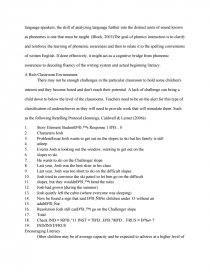Teaching the Slow Learner in Elementary School
Essay by review • July 5, 2011 • Research Paper • 1,402 Words (6 Pages) • 1,773 Views
Essay Preview: Teaching the Slow Learner in Elementary School
Abstract
An underachiever in school can find themselves grouped under a generalized classification much too easily. A child should not be grouped with a group of underachievers and be placed under one certain classification and this happens much too often in our schools. A teacher must be aware of very specific and very personal problems that can cause a child to be considered an underachiever or a slow learner.
Confusion regarding this topic needs to be reduced in our schools. Some teachers are just too quick to identify and also to attempt to correct learning disabilities without the proper training or knowledge on the subject.
Developing Strategies to Impart Learning
There are several general categories into which most teachers will tend to group each child who is a slow learner. The classifications will be made according to the likeness of a child with each group.
We need to FIRST realize that all children who are performing under their grade level are not necessarily underachievers. A lot of schools feel that all children should be exactly at the same level in each class and this is not true. Sometimes they will think that the children in this classification of slow learners are not capable of achieving at their chronological grade level. Sometimes, from the first grade on to other higher grades, a child just hasn't mastered the basic skills of learning. These children can get frustrated and even convince themselves that they cannot learn. In this instance teachers need to work with these students to teach the basic skills necessary for learning at the rate of normal student for his age. (Barr, R., Blachowicz, C. L. Z., Katz, C., & Kaufman, B., 2002).
Connections between Language Acquisition Process, Speech, Reading & Writing
Some children have problems with language development. A lack of language development can cause a child to be a slow learner. It is of much importance to see if a child has grown in the art of language and reading achievement, if not teachers need to work with these students to bring up their language levels so that they can reach maximum achievement in their class.
Theoretical Understanding of the Reading Process
Some children have cultural disadvantages as they may come from homes where, for example, the parents are not speaking English and are speaking another language. They can be known as culturally disadvantaged as they do not have essentials necessary for learning. In this instance teachers need to work with the students so that they can achieve and not be doomed to a failed and frustrated attitude. If this is left undone, then as the years pass there will be more and more problems in learning coming from cultural disadvantages in the home.
Phonics as an Assessment Tool to Identify Reading Problems
The phonics vs. whole language distinction has at least two realities: (1) as a split in instructional philosophies for teaching the acquisition and development of beginning literacy and (2) as a rather heated political debate playing itself out in the English-speaking countries (no doubt most divisively in the United States). I will look at the concepts of phonics and whole language in relation to these two contexts and then attempt to show how these concepts might prove meaningful and useful to EFL literacy.
Phonics is a way of teaching reading and spelling that stresses symbol-sound relationships, used especially in beginning instruction (Harris & Hodges, 1995, p. 186). This definition, of course, refers specifically to beginning instruction of native language literacy. There is a large set of different phonics approaches to such instruction, including: analytic, cluster, deductive, explicit, extrinsic, implicit, inductive, intrinsic, letter, synthetic, and whole-word (Harris & Hodges, 1995, p. 186)
While the ability to break words down into syllables comes fairly natural to native language speakers, the skill of analyzing language further into the distinct units of sound known as phonemes is one that must be taught. (Block, 2003)The goal of phonics instruction is to clarify and reinforce the learning of phonemic awareness and then to relate it to the spelling conventions of written English. If done effectively, it might act as a cognitive bridge from phonemic awareness to decoding fluency of the writing system and actual beginning literacy.
A Rich Classroom Environment
There may not be enough challenges in the particular classroom to hold some children's interest and they become bored and don't reach their potential. A lack of challenge can bring a child down to below the level of the classrooms. Teachers need to be on the alert for this type of classification of underachiever as they will need to provide work that will stimulate them. Such as the following Retelling Protocol (Jennings, Caldwell & Lerner (2006))
1. Story Element Student’s Response 1 Ð'Ð... 0
2. Characters Josh
3. Problem/Issue Josh wants to get out on the slopes to ski but his family is still
4. asleep
5. Events Josh is looking out the window, wanting to get out on the
6. slopes to ski
7. He wants to ski on the Challenger slope
8. Last year, Josh was the best skier in his class
9. Last year, Josh was too short to ski on the difficult slopes
10. Josh tried to convince the ski patrol to let him go on the difficult
11. slopes, but they wouldn’t bend the rules
12. Josh had grown (during the summer)
13. Josh quietly left the cabin (where everyone was sleeping)
14. Now he found a sign that said “No children under 15 without an
15. adult”
...
...




